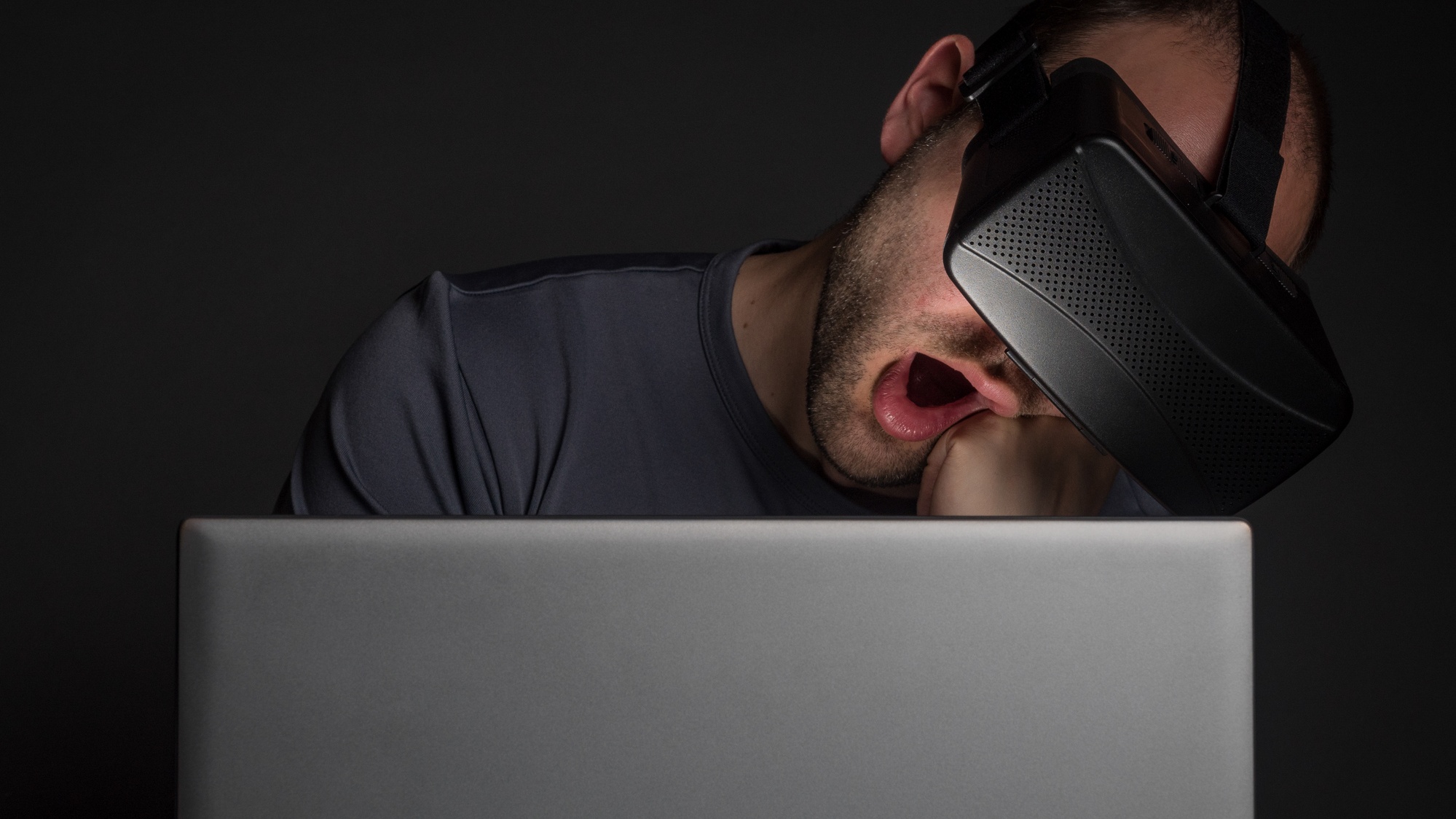5 issues Meta faces with VR workplace adoption — is a metaverse-based workforce truly our future?
Is working in the metaverse just a pie-in-the-sky idea?

Wouldn’t it be nice to wake up in the morning and all you’d need to do is put on your Quest 2 (or Quest Pro) VR headset, dress up your 3D avatar with a cool new digital outfit, and meet your co-workers in the metaverse?
It’s the sci-fi utopia I’ve been waiting for my entire life!
However, after navigating the nascent, corporate side of the metaverse, perhaps this dream is a little more far-fetched than I thought. No, I’m not a metaverse naysayer. In fact, Meta’s vision of a vast simulated universe — a plane beyond the physical realm — where people can immersively embody 3D avatars and socialize, work and play with strangers all around the world sounds enchanting.

Last year, when Meta invited me to explore Horizon Workrooms, a collaboration app that lets you work with others in a VR “office,” I was blown away with the intricate details the social media giant focused on to ensure that the experience mimicked the real world.
For example, when a Workrooms’ participant, represented as a cartoonish 3D avatar, moved their head away from me, the volume of their voice dropped. However, as they turned their head to face me again, the volume amplified. Thanks to spatial audio, you could even “tell” if someone was standing next to you — or a couple of feet away. On the flip side, there are also unrealistic elements to Workrooms that makes it a fantastical place to work. Case in point: there’s no way you can teleport from one chair to another to escape an annoying co-worker in real life, but you can totally do it in the metaverse.

Still, there are major, significant challenges Meta needs to beat — and I’m sure CEO Mark Zuckerberg agrees — before it can confidently say that working in the metaverse is truly our future.
1. Concerns about how VR affects health
If working in the metaverse becomes our new normal one day, the ol’ 40-hour work week better be slashed to 10 to 15 hours a week. You’ve got to wonder, “Is staring at two LCD monitors for eight hours a day even good for your health?” You can argue that working has never been the healthiest part of our day anyway, especially if you’re an office employee. Even as things stand now, sitting for hours and hours on end while staring at a computer screen takes a toll on your body (unless you get a standing desk or a treadmill desk).
Sign up to receive The Snapshot, a free special dispatch from Laptop Mag, in your inbox.

However, when you add a VR headset into the mix, you’re sitting for countless hours and positioning your eyes much closer to two glaring panels. I often find myself getting lost in some of the best games on the Quest 2, and before I know it, three hours have passed — my eyes get strained (and sometimes start twitching) and a faint headache suddenly appears. And this is with the Quest 2’s eye-safe feature turned on, which reduces blue-light hues.
However, my lone personal experience isn’t weighty enough to claim that VR headsets do a number on your health, right? Let’s take a look at some studies to get a better perspective on how virtual reality affects our well being.
One fascinating study followed 16 people who worked in VR for eight hours a day during a span of five days. "We found concerning levels of simulator sickness [...] and two participants dropped out on the first day using VR due to migraine, nausea and anxiety,” the report said. Participants experienced 48% more eye strain, 42% more frustration and 19% more anxiety in VR (compared to a physical, real-life work environment). Yikes!

A report from Anses, a French agency that focuses on occupational health concerns, highlighted VR headsets’ high blue-light content, which leads to delayed and disrupted sleep. However, it’s important to note that Anses emphasized that these effects are short-term and reversible.
After asking its participants to perform painting and omnidirectional tasks with the Oculus Rift, one 2020 study published in Applied Ergonomics discovered that prolonged VR headset use causes neck and shoulder muscle strain.
These studies may be alarming, but keep in mind that many of the sample sizes in the aforementioned experiments were too small to be significant. On top of that, analyses about the long-term effects of prolonged VR headset use is scant. As such, I can’t definitively say that metaverse-based workplaces pose a critical health risk, but I also can’t say it doesn’t. We need more longitudinal studies to know for sure.
2. Confusing setup and technical difficulties
Meta’s Horizon Workrooms isn’t the most intuitive app. Although I had no issues joining Meta CTO Andrew Bosworth inside the Workrooms app last year as he boasted about its awesome features to members of the press, it was an absolute nightmare trying to join a room with my co-worker Darragh Murphy on a separate occasion.
It’s not our fault, though. The setup process is pretty labyrinthine. You’ve got to create a Workrooms account, download the Oculus Remote Desktop (this app lets you use your computer in VR), download the Workrooms app, pair your Workrooms account with your Quest 2 headset, map out your physical, real-life table (so the app can track the surface you’re working on), and navigate the confusing app to invite your co-worker to a private, VR office. Whew!

Darragh and I are tech savvy, but still, we couldn’t figure out how to meet each other inside Workrooms. I’d make it to the VR office just fine as a 3D avatar, but Darragh would show up on a video-conferencing monitor in the simulated room. After 30 minutes of trying to figure it out, we eventually gave up and huffed in frustration.

Finally, unless an enterprise decides to pay for everyone’s high-speed internet to ensure consistency across the board, expect latency issues, network disconnection, and other headaches that will inevitably interrupt every VR work session.
3. Rivals are a threat to Meta
There are plenty of other VR workplace apps in the Meta Quest Store that rival Workrooms. Our favorite one so far is the Meet-in VR app. No need to download several apps and scratch your head over a confusing user interface — hell, you don’t even need to sign up for an account.

With this app, Darragh and I worked together in the metaverse without a hitch. We could project our own personal photos and videos onto a massive screen in our VR room, launch presentations, write and draw on whiteboards, sit around a swanky, outdoor office with a firepit, and even break out party poppers to celebrate our success!
Meta could potentially get eclipsed by competitors on its own platform, so it better watch out!
4. Accommodating everyone’s devices is challenging
What many don’t know about Workrooms is that, if you have a MacBook, the app can track your device, allowing you to see and use it inside the VR workplace. As such, you don’t need to constantly lift your headset off your eyes to type notes, browse the web, and more.

However, there’s one problem: I don’t have an Apple laptop — and many others are in the same boat. As such, I asked Bosworth whether Meta planned to allow other laptops to join the party. Long story short, he said that it’s a goal they’re hoping to accomplish, but adding support for non-MacBook devices is more challenging than they anticipated. Keyboard layouts vary wildly among users, so finding a way to accommodate everyone is quite a pain in the butt for Meta.
However, this can be easily settled if the company simply purchases MacBooks for all of its employees. If not, working in VR will be difficult for a team with a hodgepodge of laptops.
5. Skepticism
Unfortunately, Meta doesn’t have the best reputation. As a social media giant, it doesn’t make money from folks who scroll through Facebook and Instagram, so it discovered a way to turn a profit by packaging its users as the product. Consequently, public trust in Meta began trending downward for years due to data-sharing scandals and other controversial practices.
It doesn’t help that Meta recently made headlines for adding a new addition to its privacy policy following its Quest Pro reveal: the company intends to use eye-tracking data to help Meta “personalize your experiences and improve Meta Quest.” Keep in mind that the words “personalizing your experience” is a euphemism for targeted ads. Meta’s head of global affairs Nick Clegg told Financial Times that eye-tracking data will be used to determine how well people are engaging with their ads.
Naturally, this is unsettling to hear considering the explosive, disturbing report that hit the news cycle in 2014 when Facebook was accused of manipulating the emotional state of nearly 700,000 users. As Gizmodo said, “Tracking your eyes and face will give the company unprecedented insight about your emotions.” The tech outlet added that eye-tracking can be used to determine what you’re thinking about buying. For example, if you looked at a pair of sneakers for your avatar for far too long, who knows? Maybe you’ll get a coupon code to buy a similar one at Nike a few hours later.
Outlook
If we conceptualize the metaverse as this vast social arena beyond our realm that lets you attend virtual concerts led by your favorite artists, shop at digital malls for clothes that you can ship to yourself, play games in a way that mimics real-life physics, and more, I could totally see it being a “thing” in a decade or so. Hell, at one point, I attended Burning Man in VR — an experience so wild, peculiar and outlandish, I struggled to articulate the eccentric festivities. That being said, I can see the metaverse resonating with the masses as an entertaining escape from the real world.
But do I foresee a significant, game-changing shift from the physical world to the metaverse in the workforce? Not yet. Sure, I can see Meta winning over a few niche audiences who would love to use their Quest Pro headset every once in a while as a cross-referencing tool as they erect several virtual monitors in VR, allowing users to quickly glance between their simulated screens and laptops. Beyond that, however, I’m a skeptic. Still, I secretly hope Meta proves me wrong.
Kimberly Gedeon, holding a Master's degree in International Journalism, launched her career as a journalist for MadameNoire's business beat in 2013. She loved translating stuffy stories about the economy, personal finance and investing into digestible, easy-to-understand, entertaining stories for young women of color. During her time on the business beat, she discovered her passion for tech as she dove into articles about tech entrepreneurship, the Consumer Electronics Show (CES) and the latest tablets. After eight years of freelancing, dabbling in a myriad of beats, she's finally found a home at Laptop Mag that accepts her as the crypto-addicted, virtual reality-loving, investing-focused, tech-fascinated nerd she is. Woot!

